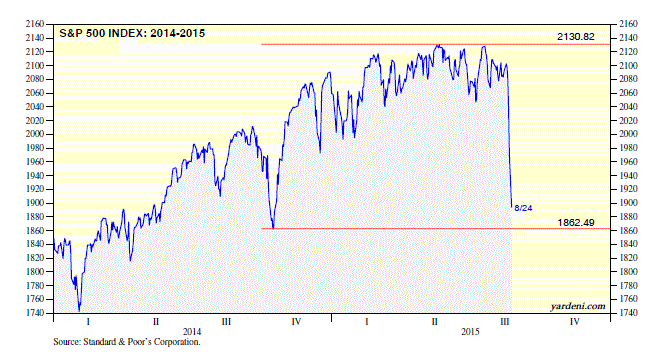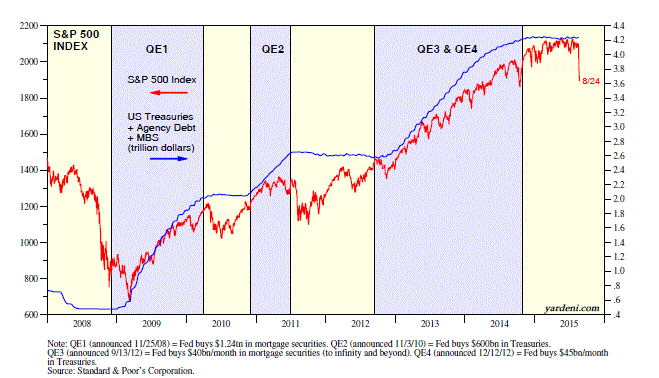The S&P 500 closed at 1893.21 yesterday. That puts it down 11.2% from its record high on May 21, down 8.0% YTD, and down 5.2% y/y. There was some chatter about the PBOC lowering the required reserve ratio for banks over the weekend, which didn’t happen. Instead Xinhua, China's official news agency, reported on Sunday that under the new rules, China’s giant pension fund will be allowed to invest up to 30% of its net assets in domestically listed shares.
No one was impressed: The Shanghai Composite Index plunged more than 8% yesterday. The Chinese media dubbed the collapse “Black Monday.” It was dark in New York as well.
During the first couple of weeks of October last year, the stock market was having another taper tantrum as the Fed was on course to terminate QE by the end of the month. The market rebounded dramatically on October 16, following a comment from FRB-SL President James Bullard that the FOMC should consider extending its bond-buying program beyond October due to the market selloff, waiting to see how the US economic outlook evolves. Yet in his interview with Bloomberg News, he also said he still believed that the FOMC should start raising the federal funds rate in March of this year.
QE was terminated on schedule, and the S&P 500 continued to rally to an all-time record high of 2130.82 on May 21. Nevertheless, many investors have been nervous, particularly the ones who’ve noted the strong correlation between the Fed’s balance sheet and the S&P 500.
This time, Bullard might have contributed to the recent panic selloff by exacerbating the market’s tightening tantrum. On Friday, as the stock market was tanking following Thursday’s plunge, Bullard, who is one of the most talkative of the Fed’s talking heads, was interviewed on SiriusXM Business Radio. He suggested that despite the turmoil in the financial and commodity markets, the FOMC should proceed with its first rate hike at the committee’s September 16-17 meeting. Bullard said the Fed doesn’t react to financial markets directly unless they influence the economy. While crude oil prices slumped to the lowest level since 2009, he said the bulk of the decline over the past year has been driven by increased supply rather than lower global demand.
Earlier on Friday, the Richmond Fed said its president, Jeffrey Lacker, will give a speech on September 4 titled “The Case Against Further Delay.” Yesterday, Lockhart stuck to his guns, saying he still expects the FOMC to raise short-term interest rates in the next few months, even as he recognized some of the stresses facing the US economy and financial markets.
So what will the FOMC decide to do at its September meeting? Given the turmoil in financial and commodity markets, Fed officials are likely to postpone a rate hike until their December 15-16 meeting. By then, there might be less commotion. Of course, another possibility is that one-and-done will be none-and-done this year, and maybe even next year.
Today's Morning Briefing: Retracing the Bullard Bounce. (1) Bullard Bounce without Bullard? (2) From taper tantrum to tightening tantrum. (3) From one-and-done to none-and-done? (4) The famous airplane scene in “Almost Famous.” (5) Maybe commodity prices are near their lows after falling so far over the past year. (6) Maybe the worst is over for non-dollar currencies. (7) Is it too late to panic? (8) The alternatives to stocks are mostly near-zero interest rates. (9) Global economy is chronically weak, but recession still seems unlikely. (10) Forward earnings remain near record highs for S&P 500/600/400.


